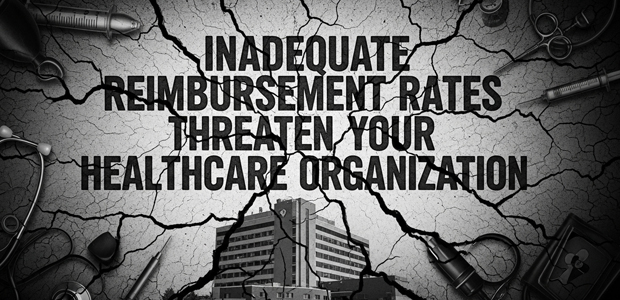Healthcare organizations across the United States face an unprecedented crisis that strikes at the very foundation of their operational sustainability. Inadequate reimbursement rates from insurance providers, government programs, and other payers have created a perfect storm of financial pressures that threaten the viability of hospitals, clinics, and healthcare systems nationwide.
 This mounting crisis extends far beyond simple accounting concerns, fundamentally altering how healthcare institutions deliver care, maintain quality standards, and plan for future growth.
This mounting crisis extends far beyond simple accounting concerns, fundamentally altering how healthcare institutions deliver care, maintain quality standards, and plan for future growth.
The gap between the actual cost of providing medical services and the compensation received from payers has widened dramatically over the past decade. Healthcare organizations find themselves caught in an increasingly unsustainable cycle where the expenses of delivering quality care continue to rise while reimbursement rates remain stagnant or even decline.
This disparity creates operational challenges that ripple through every aspect of healthcare delivery, from staffing decisions to equipment purchases, and ultimately impacts patient care quality.
The Financial Reality of Modern Healthcare Operations
Healthcare organizations operate within a complex financial ecosystem where multiple factors influence their bottom line. Knowing the true scope of inadequate reimbursement requires examining the various cost centers that drive healthcare expenses and how current payment models fail to address these realities.
Primary cost drivers affecting healthcare organizations include:
- Personnel expenses – Representing 50-70% of most healthcare budgets, including physician salaries, nursing staff, support personnel, and benefits
- Medical equipment and technology – Ongoing investments in diagnostic equipment, treatment devices, and health information systems
- Pharmaceutical and supply costs – Rising drug prices and medical supply expenses that often outpace inflation
- Infrastructure maintenance – Building operations, utilities, security, and facility upgrades required for modern healthcare delivery
- Regulatory compliance – Costs associated with meeting quality standards, safety regulations, and reporting requirements
- Professional liability insurance – Increasing premiums driven by litigation risks in healthcare environments
Meanwhile, reimbursement rates from major payers have failed to keep pace with these rising costs. Government programs like Medicare and Medicaid, which serve a significant portion of the patient population, often reimburse healthcare providers at rates below the actual cost of care delivery. Private insurance companies, facing their own financial pressures, negotiate increasingly restrictive contracts that limit payment amounts and impose additional administrative burdens.
Impact on Healthcare Quality and Access
The consequences of inadequate reimbursement extend far beyond financial statements, directly affecting the quality and accessibility of healthcare services. Healthcare organizations facing financial strain must make difficult decisions that can compromise their ability to deliver optimal patient care.
Service reduction strategies commonly employed include:
- Elimination of unprofitable service lines – Discontinuing specialized programs or services that operate at significant losses
- Reduced operating hours – Limiting clinic hours, emergency department availability, or surgical schedules
- Deferred maintenance and upgrades – Postponing necessary equipment replacements or facility improvements
- Staffing reductions – Implementing hiring freezes, layoffs, or increased patient-to-staff ratios
These measures create a cascading effect throughout the healthcare system. Patients may face longer wait times for appointments, reduced access to specialized services, or the inconvenience of traveling greater distances for care. The quality of care can suffer when healthcare organizations are forced to operate with inadequate resources or outdated equipment.
Rural and underserved communities bear a disproportionate burden from inadequate reimbursement rates. These areas often rely heavily on government-funded programs like Medicare and Medicaid, which typically offer lower reimbursement rates than private insurance. Small rural hospitals, in particular, face unique challenges as they serve populations with higher rates of government insurance coverage while maintaining the same operational costs as their urban counterparts.
The Medicare and Medicaid Challenge
Government healthcare programs present both opportunities and challenges for healthcare organizations. While these programs provide essential coverage for vulnerable populations, their reimbursement methodologies often fall short of covering the true costs of care delivery.

Medicare reimbursement rates are typically calculated using complex formulas that may not accurately reflect regional cost variations or the specific needs of different healthcare organizations. The program’s focus on cost containment, while important for fiscal responsibility, can create situations where providers struggle to maintain financial viability while serving Medicare beneficiaries.
Medicaid programs, administered at the state level, face even greater reimbursement challenges. Many states, constrained by budget limitations, set Medicaid reimbursement rates at levels significantly below Medicare rates. This creates particular hardships for healthcare organizations that serve large populations of low-income patients who rely on Medicaid coverage.
Key challenges with government program reimbursements:
- Below-cost reimbursement rates that fail to cover the actual expenses of providing care
- Administrative complexity requiring significant resources for billing and compliance
- Delayed payment processing that affects cash flow and operational planning
- Frequent policy changes that require ongoing adjustments to billing and operational procedures
- Limited appeal processes for disputed claims or inadequate payments
Private Insurance Negotiations and Market Dynamics
Private insurance companies, while generally offering higher reimbursement rates than government programs, present their own set of challenges for healthcare organizations.
 The negotiation process for insurance contracts has become increasingly complex, with insurers seeking to control costs through various mechanisms that can limit provider compensation.
The negotiation process for insurance contracts has become increasingly complex, with insurers seeking to control costs through various mechanisms that can limit provider compensation.
Insurance companies employ sophisticated strategies to manage their financial exposure while maintaining coverage for their members. These strategies often include narrow network designs, value-based payment models, and risk-sharing arrangements that transfer financial responsibility to healthcare providers.
While these approaches may achieve cost control objectives for insurers, they can create additional financial risks for healthcare organizations.
Common private insurance tactics affecting reimbursement:
- Prior authorization requirements that delay or prevent certain treatments
- Claims denial strategies that shift administrative costs to providers
- Narrow network agreements that limit patient choice while reducing provider leverage
- Bundled payment arrangements that may not account for patient complexity variations
- Performance-based adjustments that can reduce payments based on quality metrics or utilization patterns
Healthcare organizations must navigate these complex relationships while advocating for fair reimbursement rates that reflect the true cost of care delivery. The negotiation process requires significant resources and expertise, particularly for smaller healthcare organizations that may lack the bargaining power of large health systems.
Operational Strategies for Financial Sustainability
Healthcare organizations must develop sophisticated strategies to address the challenges posed by inadequate reimbursement rates. These approaches require careful planning, investment in technology and processes, and ongoing adaptation to changing market conditions.
Revenue optimization strategies include:
- Enhanced coding and documentation – Ensuring accurate capture of all billable services and appropriate coding complexity
- Charge capture improvement – Implementing systems to identify and bill for all provided services
- Denial management programs – Developing robust processes to appeal denied claims and reduce write-offs
- Contract negotiation expertise – Building internal capabilities or partnering with specialists to optimize payer contracts
- Alternative payment model participation – Engaging in value-based care arrangements that may offer better financial outcomes
Cost management approaches encompass:
- Supply chain optimization – Leveraging group purchasing organizations and negotiating better vendor contracts
- Workforce efficiency – Implementing staffing models that optimize productivity while maintaining quality
- Technology investments – Adopting systems that reduce administrative costs and improve operational efficiency
- Process standardization – Eliminating redundancies and streamlining workflows across the organization
- Energy and facility management – Reducing operational costs through efficient building management and maintenance
The Role of Technology in Addressing Reimbursement Challenges
 Healthcare information technology plays a crucial role in helping organizations manage the complexities of modern reimbursement systems. Advanced electronic health record systems, revenue cycle management platforms, and analytics tools can significantly improve an organization’s ability to capture appropriate reimbursement while reducing administrative costs.
Healthcare information technology plays a crucial role in helping organizations manage the complexities of modern reimbursement systems. Advanced electronic health record systems, revenue cycle management platforms, and analytics tools can significantly improve an organization’s ability to capture appropriate reimbursement while reducing administrative costs.
Artificial intelligence and machine learning technologies are increasingly being deployed to identify patterns in claims denials, predict payment delays, and optimize coding accuracy. These tools can help healthcare organizations proactively address potential reimbursement issues before they impact cash flow or operational performance.
Technology solutions addressing reimbursement challenges:
- Automated coding systems that improve accuracy and reduce labor costs
- Predictive analytics for identifying at-risk accounts or payment delays
- Patient financial engagement platforms that improve collection rates and reduce bad debt
- Integration platforms that streamline data flow between clinical and financial systems
- Real-time eligibility verification that reduces denied claims and administrative costs
Building Resilience for Tomorrow
![]()
Healthcare organizations that successfully navigate the challenges of inadequate reimbursement rates share common characteristics that enable their long-term sustainability. These organizations typically invest in building strong financial management capabilities, develop diverse revenue streams, and maintain focus on operational efficiency while preserving quality care delivery.
Strategic planning becomes essential for healthcare organizations facing reimbursement pressures. This planning must address both immediate financial challenges and long-term sustainability objectives. Organizations need to carefully balance cost reduction initiatives with investments in technology, staff development, and service quality that will position them for future success.
The healthcare industry continues to transform through consolidation, new payment models, and changing patient expectations. Healthcare organizations that anticipate these changes and adapt their strategies accordingly will be better positioned to thrive despite ongoing reimbursement challenges.
Key success factors for long-term sustainability:
- Diversified revenue streams that reduce dependence on any single payer source
- Strong financial management with sophisticated budgeting and forecasting capabilities
- Quality improvement programs that enhance reputation and support premium pricing
- Strategic partnerships that provide economies of scale and shared resources
- Community engagement that builds support for the organization’s mission and services
- Continuous improvement culture that identifies and implements operational efficiencies
Leaders must remain vigilant in monitoring healthcare reimbursement trends, advocating for fair payment policies, and implementing strategies that ensure their organizations can continue fulfilling their essential mission of providing quality healthcare services to their communities. The stakes are too high, and the mission too important, to allow inadequate reimbursement rates to compromise the future of healthcare delivery.
Contact us to handle all of your healthcare reimbursement needs and/or challenges.

